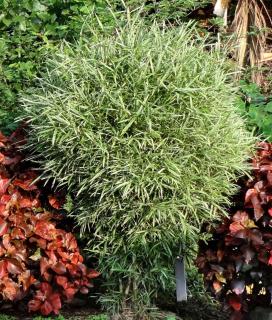

Want to give your garden a tropical touch? Plant bamboo! But choose the right one – some varieties are extremely invasive…
In the grasses family, bamboo is the only woody plant. It continuously sends new shoots out, just like grass. Running bamboo types (Arundinaria, Chimonobambusa, Phyllostachys, Pseudosasa…), after a few years, can colonize entire plots and gobble up space.
 Much easier, though, are non-running bamboo varieties. These stay put in the garden, produce dense, compact bunches and won’t spread invasively. Some examples of such bamboos are Fargesia, Bambusa (for milder climates), Thamocalamus, Chusquea, certain types of Yushamia… Still others, like Shibataea, are easily controlled with a simple spade.
Much easier, though, are non-running bamboo varieties. These stay put in the garden, produce dense, compact bunches and won’t spread invasively. Some examples of such bamboos are Fargesia, Bambusa (for milder climates), Thamocalamus, Chusquea, certain types of Yushamia… Still others, like Shibataea, are easily controlled with a simple spade.
Bamboo will always expand outwards every growing season, and in the end can easily reach to over six feet (two meters) across. The Phyllostachys family produces tall bamboo clumps, some of which will quickly feel tight growing in a small garden. But if one thing is certain, it’s that there’s guaranteed to be a species that is perfect for your own plot of land because there are so many of them!
Once you’ve made your decision, you can transplant your bamboo to the ground in any season, but if you want optimal root development, favor fall.
Before setting your plant in the ground, sprinkle manure in the hole to enhance regrowth. Rake up a small ridge around the plant to keep water in when watering.
If you’ve chosen a variety that spreads fast, or if you’re not exactly sure what type of bamboo you’re plant, then set a rhizome barrier up right from the start, at least 2 to 3 feet deep (65 to 95 cm). This will mark out the space it’s allowed to colonize.

That way, it’s guaranteed they won’t break free!
Regularly chop off these rhizomes that reach the barrier to keep them from going around in circles and suffocating the plant.

You can also grow them in garden boxes as long as you water them abundantly in summer.
It’s fast growing pace makes it an excellent option to set up a hedge that will remain green all year round.
M.-C. H.